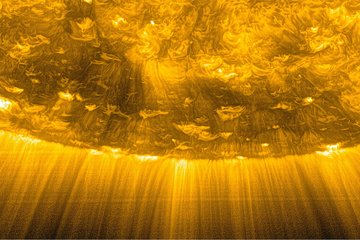All genres
21.
Journal Article
Influence of Magnesium Perchlorate on the Pyrolysis of Organic Compounds in Mars Analogue Soils. Planetary and Space Science 71, pp. 9 - 17 (2012)
22.
Journal Article
MOMA: Mars Organic Molecule Analyzer: Instrument concept and results. Geochim. Cosmochim. Acta 74 (12), p. A67 - A67 (2010)
23.
Journal Article
MOMA: Mars Organic Molecule Analyser. Geochimica et Cosmochimica Acta, 12 (2010)
24.
Journal Article
Two Rovers to the Same Site on Mars, 2018: Possibilities for Cooperative Science. Astrobiology 10, pp. 663 - 685 (2010)
25.
Journal Article
MOMA-Ldms: Instrument concept and results. Geochim. Cosmochim. Acta 73 (13), p. A101 - A101 (2009)
26.
Journal Article
Triple F-a comet nucleus sample return mission. Experimental Astronomy 23, pp. 809 - 847 (2009)
27.
Journal Article
Triple F—a comet nucleus sample return mission. Experimental Astronomy 23 (3), pp. 809 - 847 (2009)
28.
Journal Article
COSAC, the cometary sampling and composition experiment on Philae. Space Science Reviews 128 (1-4), pp. 257 - 280 (2007)
29.
Journal Article
The COSAC experiment of the Rosetta mission: Performance under representative conditions and expected scientific return. Advances in Space Research 40 (2), pp. 180 - 186 (2007)
30.
Journal Article
COSAC onboard Philae: a bioastronomy experiment for the short-period comet 67P/Churyumov-Gerasimenko. Astrobiology 5, No.5, pp. 622 - 631 (2005)
31.
Journal Article
Analysis of cometary matter by the COSAC instrumentation onboard ROSETTA lander. Part II: chiral organic molecules. Geophysical Research Abstract 4, p. 1030 (2002)
32.
Journal Article
Enantioselective amino acid analysis in cometary matter planned for the COSAC instrument onboard ROSETTA lander. International Journal of Astrobiology 1, p. 255 (2002)
33.
Journal Article
Gas chromatography for in situ analysis of a cometary nucleus - IV. Study of capillary column robustness for space application. J. Chromatogr. A 982 (2), pp. 303 - 312 (2002)
34.
Journal Article
Analysis of cometary matter by the COSAC instrumentation onboard ROSETTA lander. Part I: inorganic and organic molecules. Geophysical Research Abstract 4, p. 1210 (2002)
35.
Journal Article
Enantiomer separation of hydrocarbons in preparation for ROSETTA's chirality experiment. Chirality 13 (8), pp. 454 - 457 (2001)
36.
Journal Article
Separation of cometary enantiomers by Rosetta/Roland. Geophysical Research Abstract 3, p. 7597 (2001)
37.
Journal Article
The COSAC experiment on the lander of the ROSETTA mission. Advances in Space Research 23, pp. 333 - 340 (1999)
38.
Journal Article
Gaschromatography for in situ analysis of a cometary nucleus: charcterisation and optimisation of diphenyl/dimethylpolysiloxane stationary phases. Journal of Chromatography A 863, pp. 157 - 169 (1999)
39.
Book Chapter
Searching for Traces of Life With the ExoMars Rover. In: From Habitability to Life on Mars, pp. 309 - 347 (Eds. Cabrol, N. A.; Grin, E. A.). Elsevier, Amsterdam (2018)
40.
Conference Paper
The Electron Macroscope. In: Proceedings of the 37th ESLAB symposium, ``Tools and technologies for future planetary exploration'', Noordwijk, The Netherlands, 2-4 Dec. 2003, pp. 183 - 186. (2004)










